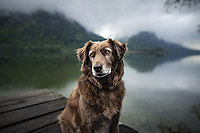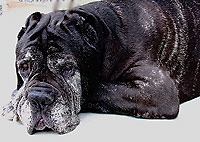If your dog is 7 years or older, she’s considered a senior, and while she may still be a puppy in your eyes and even behave like one most days, it’s still important to acknowledge she’s aging. It’s important to begin making plans to transition from puppy or adult dog parent to devoted guardian of a senior and ultimately, geriatric dog.
Older canine family members require different things from us than younger dogs do, and since I know you want to not only help your pet live as long as possible, but also with an excellent quality of life as she ages, now is a good time to give the subject some careful thought. Thankfully, as our dogs get up in years, we’re given a unique and wonderful opportunity to make the second half of their lives as healthy and happy as the first half.
Fine-tune his diet as necessary and make sure it includes plenty of high-quality protein. Almost every dog thrives on a whole, unprocessed species-specific diet, but aging pets need more protein than younger animals. The more digestible and assimilable the protein, and the higher the moisture content of the food, the easier it will be for aging organs to process.
The healthiest diet for most pets, regardless of age, is unprocessed or minimally processed food as close to its natural form as possible: this includes animal meat, which should be the foundation of your healthy dog’s diet throughout his life. Foods that haven’t been refined or highly processed provide the most nutrients. Try to steer clear of any commercial pet food containing a high percentage of carbs, no matter your dog’s age or weight. The presence of carbs (greater than 20%) in commercial pet food is excessive and metabolically stressful.
Exercise her every day. Senior and even geriatric dogs still need daily exercise to maintain good health and physical conditioning. Of course, older dogs can’t exercise or compete at the same level as their younger counterparts, but they still need regular walks and other age-appropriate physical activity. Swimming is one of my favorite ways to exercise older pets.
There are three types of anti-aging exercises that can also be of tremendous benefit to aging canine bodies:
• Passive range-of-motion (PROM) exercises
• Exercises that maintain balance and fluid movement
• Exercises that target the big, body-supporting muscles like the hamstrings and gluteals
Gentle stretching is also a great natural tool to improve the well-being and longevity of your dog. People certified in animal rehabilitation can teach you appropriate exercises you can do at home to improve balance, proprioception and range of motion. Ask your veterinarian to connect you with local rehab specialists.
Preserve his physical comfort and mobility. If your dog seems physically uncomfortable, don’t just assume it’s just a natural part of aging. You want to make sure he’s not in pain, so a visit to your veterinarian is in order. The sooner a health problem is diagnosed and treated, in most cases, the better the outcome.
Keeping your dog at a healthy weight and physically active will help control arthritis and degenerative joint disease as he ages. Chiropractic adjustments and acupuncture can provide enormous benefits in keeping dogs mobile in their later years, along with water exercises. In addition, talk to your veterinarian about Adequan injections, which can stimulate joint fluid very rapidly in pets with arthritis. Regular massage can help keep your senior dog’s muscles toned and reduce the slackening that comes with aging. Massaged muscles are looser, which makes it easier for your pet to move around comfortably. Massage also improves circulation, encourages lymphatic drainage, and eases joint stiffness.
There are a wide range of supplements that can be added to your dog’s diet to help maintain healthy tendons, ligaments, joints and cartilage as they age. These include:
• Chondroprotective agents such as glucosamine sulfate, MSM, eggshell membrane, Perna mussel (green lipped clam), and organic collagen
• Anti-inflammatory fatty acids, including omega-3 fats (krill oil) and acetylated fatty acids
• Natural anti-inflammatory formulas (curcumin, Boswellia, proteolytic enzymes and nutraceuticals)
Consider purchasing or building ramps for a dog who is having trouble getting into the car or up on the bed or a favorite chair. This can also help prevent injuries in aging dogs. If he’s having trouble with balance or vision, consider gating off stairways or adding safety treads to prevent slipping. Be sure to add rubber grippers under any throw rugs to prevent falls. Cover slick surfaces with yoga mats to prevent slips, trips or falls. If his vision is failing, you’ll also want to avoid rearranging furniture, which can make the space difficult for him to navigate and use extra care to ensure he doesn’t wander off when he’s outside.
Give her regular opportunities for socialization and mental stimulation. No matter how old your dog is she still needs regular social interaction with other pets and people. As is the case with humans as we age, if your four-legged family member doesn’t stay active and involved in life, her world can become a confusing, scary place. She needs regular exposure to other pets and people but take care not to over stimulate her — short periods of socialization and playtime in controlled situations are ideal.
Enriching your dog’s environment can help alleviate or stall the mental confusion and decline of cognitive function that often come with old age. In addition, sticking to a predictable daily routine can help reduce anxiety and mental uncertainty, and treat release and food puzzle toys provide fun and mental stimulation.
Supplements for brain health may also be useful, including krill oil and other healthy fats such as MCT oil, as well as a source of SAMe (S-adenosylmethionine). Other supplements to consider are SOD (superoxide dismutase), NR (nicotinamide riboside) and resveratrol (knotweed). Ginkgo biloba may improve blood flow to the brain. Phosphatidylserine and ubiquinol, which is the reduced form of CoQ10, feeds your pet’s mitochondria and improves cellular energy.
Take good care of his teeth. The right diet, regular brushing and professional cleanings can keep your dog’s teeth healthy for a lifetime. Oral disease, left untreated, can cause or worsen systemic diseases and can be painful as well. Contrary to popular belief, most older dogs (and cats) can be safely anesthetized for dental exams and teeth cleaning. Once you pay to have your pet’s teeth cleaned up, protect your investment and keep up with removing plaque as it accumulates.
Schedule her for veterinary wellness exams at least annually if not bi-annually. Ideally, canine patients are seen at least twice a year, but this is especially true for senior and geriatric dogs. Around the age of 8 (younger for some large and all giant breed dogs), your dog’s wellness and nutritional needs can require fine-tuning every 4 to 6 months. In older pets it’s very important to review weight, muscle tone, joint range of motion, diet, and exercise habits at least semi-annually. When dogs are seniors their supplement protocol will change every 6 months to meet their body’s dynamically changing needs.
The senior pet wellness screen is an excellent tool for early detection of changes in your dog’s health so that treatment, including appropriate lifestyle changes, can begin immediately. Regular wellness visits allow your veterinarian to compare current test results with past results to check for changes that may need further investigation.
Ask your vet to perform a blood test to check your pet’s internal organ health to make sure you’re identifying possible issues early on. As pets age, early detection is key, as we can slow organ disease early on (when there are no symptoms) but can’t do much once they’re in organ failure (when they begin showing symptoms). There are also a variety of functional medicine diagnostics that proactive veterinarians may recommend that provide excellent additional information about how well your pet is aging metabolically and oxidatively.
Dog-Friendly Walks/Hikes
in the Moab Area |
Corona Arch - Easy/Moderate. 1.3 Miles one way. Trailhead is 25 minute drive from Moab. North on US-191 to Potash Road (Utah 279).
Mill Creek Pathway - Easy. 1.1 Miles. Little to no driving. Starts at the intersection of 100 South and 100 West, a block off of Main Street.
Portal Overlook - Hard. 2.0 Miles one way. Trailhead is 20 minute drive from Moab. N. on US-191 to Potash Road (Utah 279).
Grandstaff Canyon - Moderate. 2.0 Miles one way. Trailhead is 10-minute drive from Moab. North on US-191 to the River Road (Utah 128) |
|